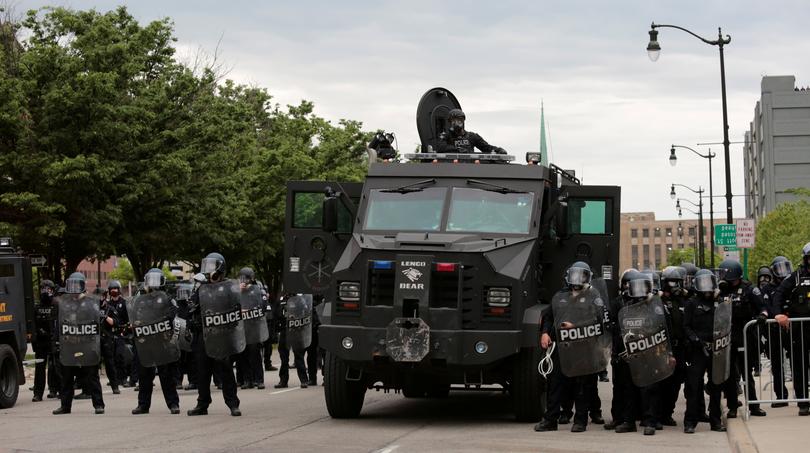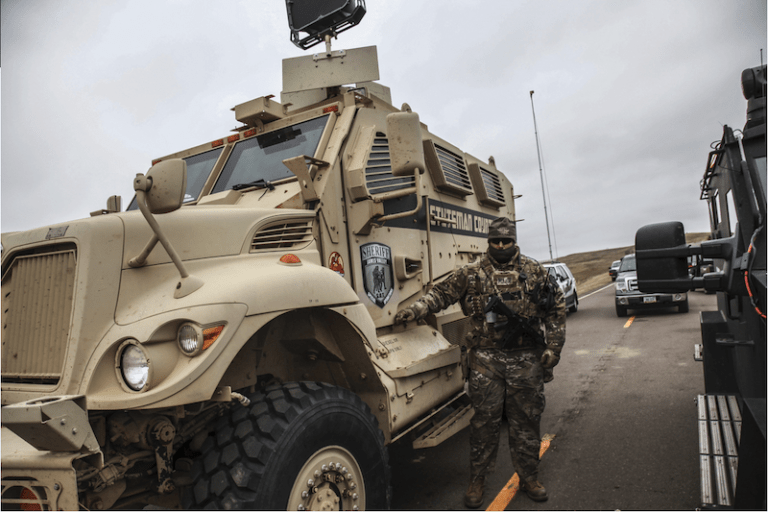by Alice Speri Originally published on The Intercept Sept. 20, 2021
When scores of protesters took to the streets of Ferguson, Missouri, following the police killing of Michael Brown seven years ago, they were met by officers in camouflage aiming sniper rifles directly at people’s faces, moving through streets lined by homes and strip malls in mine-resistant armored vehicles. It was a jarring display of police force for a suburb on the outskirts of a midsize U.S. city, and it brought much scrutiny to an at the time little-known federal program through which police departments across the country receive surplus military equipment from the Department of Defense.
The program, known as 1033, became an emblem for the militarization of American police. This week, as Congress prepares to reauthorize the National Defense Authorization Act — the legislation which sets the Pentagon’s budget — four proposed amendments seek to restrict or put an end to it.
It’s the most concerted effort yet by legislators to tackle a program that, despite sparking backlash after the Ferguson protests and then again after the police killing of George Floyd last year, has continued to funnel military equipment to police. Nearly $90 million worth of military equipment was transferred to police last year alone, and more than $7.4 billion since 1990.
A majority of Americans support ending the program, a 2020 poll from Data for Progress suggests. Yet legislative efforts to do so have floundered, as President Joe Biden has failed to reinstate modest Obama-era restrictions to the program, despite promising to do so.
The proposed amendments to the defense budget have been introduced by Democratic Reps. Nydia Velázquez and Alexandria Ocasio-Cortez of New York, Ayanna Pressley of Massachusetts, and Hank Johnson of Georgia. Velázquez’s, the most aggressive among them, seeks to end the program altogether by striking the NDAA provision that authorizes it. Ocasio-Cortez’s seeks to prohibit the transfer of a number of items, including ammunition, grenade launchers, and mine-resistant ambush-protected vehicles. The vehicles, known as MRAPs, have become a symbol of the program after they were dispatched to protests and home raids. Pressley’s seeks to issue a moratorium on all 1033 transfers. And Johnson’s seeks to limit the transfers but offers a series of carveouts and exceptions, including for counterterrorism purposes. The language of Johnson’s bill already cleared the House as part of a the George Floyd Justice in Policing Act, which has languished in the Senate.
The floor proposals, which the House Armed Services Committee will start considering on Monday, come as an earlier effort by Reps. Veronica Escobar of Texas and Ro Khanna of California to introduce a 1033 amendment at the committee level was derailed at the last minute. It’s unclear whether any of the four amendments will be taken up for a vote and whether they would pass, but people close to the proceedings believe one of the ones that would curtail but not end the program has a chance. A coalition of more than 90 groups spanning the political spectrum had endorsed Pressley’s proposed moratorium on 1033. On Monday, they sought to raise momentum around the proposal, tweeting about it under the hashtag #STOP1033.
Regardless of the outcome, advocates hope that the debate over the various amendments raise the stakes around the long-disputed program and put pressure on the Biden administration to take action on it should Congress fail to do so again.
“I think a big factor in that loss of confidence in law enforcement has been the militarization of police.”

“The momentum has been building,” Johnson told The Intercept in an interview. “Community confidence in law enforcement is probably at an all-time low at this point and I think a big factor in that loss of confidence in law enforcement has been the militarization of police.”
Johnson, who has also introduced stand-alone legislation to reform 1033 since 2014, added that the militarization of police allowed by the program “has proliferated to the point where it has actually contributed to the change of mindset in law enforcement — from that law enforcement ‘protect and serve’ mentality into more of a ‘occupier and destroy the enemy’ mentality.”
In a statement to The Intercept, Pressley pointed to the recent U.S. withdrawal from Afghanistan as a reason for Congress to act: The government declared some 17,000 pieces of military equipment “excess” ahead of the withdrawal.
“We must end the militarization of our law enforcement agencies, which for far too long have operated with impunity and used U.S. military equipment to surveil, brutalize and murder Black, brown and other marginalized communities disproportionately,” Pressley wrote. “With police departments nationwide set to receive a massive influx of military equipment under the 1033 program following the Afghanistan war, Congress must take decisive action before further lives are lost and more trauma is inflicted on our communities.”
Some of the equipment from Afghanistan could now be distributed to foreign armies through a program designed to rid the Pentagon of surplus material. Or it could end up in the hands of police. “We have no idea where that’s going,” said Stephen Semler, co-founder of the Security Policy Reform Institute. He noted that when the U.S. scaled back its military presence in Iraq, 1033 transfers to police departments at home significantly increased. “With the Iraq drawdown we saw a massive spike in transfers of military gear to police, particularly MRAPs, which were designed for Iraq.”
Oil Pipeline-Protest
A member of the Stutsman County Police SWAT team stands by a MRAP vehicle equipped with a long range acoustic device, also known as a sound cannon, while deployed to watch protesters demonstrating against the Dakota Access pipeline in Cannon Ball, N.D., on Oct. 30, 2016.
The 1033 program was a product of the war on drugs, originally authorized under the National Defense Authorization Act as a temporary measure limited to counternarcotics purposes. The program became permanent in 1997, when its scope broadened significantly to include “counterterrorism.” In 2015, it expanded once again, to include border security.
1033 is the most prominent of a series of programs through which the federal government subsidizes law enforcement’s acquisition of military-grade material. Such programs have resulted in even small-town police departments acquiring equipment better suited to war zones — and with it often a war-like mentality.
“What we wind up with is cops who look more like soldiers than police officers and who behave oftentimes more like soldiers than police officers,” Norm Stamper, a former Seattle police chief and outspoken critic of the militarization of police, told The Intercept. “We need to have a conversation about the utility, the morality, the practical, tactical, and principled issues associated with military-grade equipment on city streets.”
Following the Ferguson protests, President Barack Obama signed an executive order in 2015 to establish tighter oversight of the 1033 program and restrict the equipment police could acquire through it. The reforms included a recall of some items, like grenade launchers, tracked armed vehicles, and bayonets, some of them dating back to the Korean War. But the recall only impacted about $30 million worth of equipment, a fraction of the program’s overall value.
“The recall itself was mostly symbolic,” said Kenneth Lowande, a political science professor at the University of Michigan who studied the effort’s impact on public safety, concluding that there was no correlation between police demilitarization and crime. “While there have been lots of news stories about it, and congressional hearings about it, the way the program has functioned really has not changed that much.”
As cosmetic as the reforms had been, when Donald Trump took office, he quickly rolled them back. Biden indicated that reinstating the Obama-era restriction would be a priority — with White House officials listing the issue as part of a slate of criminal justice-related measures the incoming administration had announced for January 26, 2021.
That day, Biden signed an executive order ending the Justice Department’s contracts with private prisons, as well as other measures he said tackled “equity.” But he didn’t take any action on 1033, and the administration has not indicated why or whether it still plans to issue an order. The White House did not respond to a request for comment.
“He pledged to get weapons of war and military equipment off of our streets during the campaign.”

Civil rights advocates had lobbied Biden’s transition team to issue an executive order that would prohibit the transfer of more items than Obama’s had, while law enforcement representatives had organized against the executive action. The National Organization of Police Associations, a coalition of unions and other police groups, declared victory after 1033 disappeared from the White House’s action list, crediting the group’s pressure on senior administration officials for the outcome.
“Biden has not done anything on this program,” Yasmine Taeb, a human rights lawyer who works with a coalition of groups lobbying for an end to 1033, told The Intercept. “And he pledged to get weapons of war and military equipment off of our streets during the campaign.”
Johnson, the Georgia Democrat, told The Intercept he still expects Biden will issue an order on 1033 should efforts in Congress fail again. “But I think Congress needs to act, regardless of an executive order, because an executive order can be reversed by the next president,” he told The Intercept.
Advocates agree, and they have largely shifted their lobbying efforts from the White House to legislators.
“If Biden continues to do nothing — and that’s the indication that we’ve gotten — it’s all on Congress to make the move,” said Semler, who first wrote of NAPO’s pressure around the expected executive order.
While 1033 remains widely unpopular among the public — a 2020 Data for Progress poll showing that only 35 percent of respondents oppose making it illegal for police to acquire military equipment — Congress, so far, has done little. Last year, a proposal by Sen. Brian Schatz, D-Hawaii, to strictly limit the 1033 program failed to garner enough votes. Instead, the Senate passed a weaker amendment, by Republican Sen. Jim Inhofe of Oklahoma, imposing minimal restrictions to the transfers, including by ending those of items like weaponized drones and bayonets, which were hardly being transferred to police at all.
While it has become a symbol for hostile and aggressive policing, the 1033 program is also emblematic of the massive waste enabled by military spending that has increased exponentially over the years — with this year’s budget currently $37 billion larger than last year’s.
At one point, as much as one-third of the equipment the Defense Department transferred to police had never been used, yet department officials continued requesting and budgeting for new pieces of equipment. Police departments, for their part, added to their budgets the cost of maintaining and replacing pieces of equipment they got from the military.
“It’s just sort of this endless cycle where it’s about institutional preservation for both the Pentagon and the police,” said Semler. “They have no evidence that increases public safety — in fact, it’s the opposite. But it’s sort of this machine, just rolling along.”


